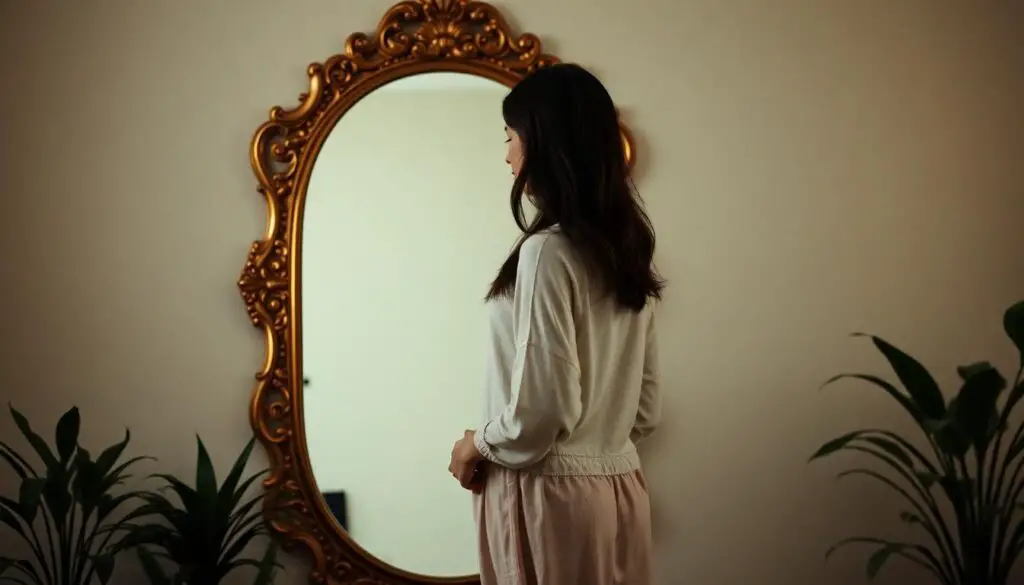Mirrors have fascinated humanity for centuries, reflecting not just our physical appearance but also glimpses into our spiritual essence. We’ve discovered that these silvery surfaces hold profound symbolic significance across various spiritual traditions, serving as portals to self-discovery and metaphysical insight.
When we gaze into a mirror, we’re captivating with more than glass and silver—we’re connecting with powerful symbols of truth, self-awareness, and soul reflection. From dream interpretations to synchronistic mirror hour sightings, these reflective objects offer valuable spiritual messages that can guide our personal growth journey. Ready to discover what mirrors might be revealing about your spiritual path?
The Symbolic Power of Mirrors Throughout History
Mirrors have captivated human imagination since ancient times, serving as powerful symbols across diverse civilizations and belief systems. Ancient Egyptians crafted mirrors from polished copper, believing these reflective surfaces represented the soul and connected the living with the afterlife. In Greek mythology, mirrors played a pivotal role in stories like Narcissus, who became entranced by his own reflection – a tale that continues to symbolize self-absorption and vanity.
Eastern traditions incorporated mirrors into spiritual practices and temple designs, with Chinese Feng Shui using mirrors to redirect energy and ward off negative influences. Buddhist traditions view mirrors as representations of clarity and wisdom, reflecting the true nature of reality without distortion. Japanese Shinto shrines feature sacred mirrors (kagami) that symbolize purity and house deities, demonstrating the mirror’s role as a spiritual vessel.
Medieval European cultures associated mirrors with divination and mysticism, using them for scrying practices to glimpse future events or distant realities. Renaissance art frequently included mirrors as symbols of vanity, truth, and self-knowledge, appearing in paintings to convey deeper philosophical meanings about human existence. Mirrors evolved beyond practical tools to become profound metaphors for truth-seeking and self-reflection throughout these historical contexts.
Indigenous cultures across continents incorporated reflective surfaces into rituals, using natural mirrors formed from water and polished obsidian for ceremonial purposes. Shamanic traditions utilized mirrors as tools for spiritual journeying, believing they created openings between worlds. The historical reverence for mirrors across cultures underscores their universal significance as objects that transcend mere functionality, instead serving as windows into deeper spiritual truths and human consciousness.
Mirrors as Tools for Self-Reflection and Awareness

Mirrors function as powerful instruments for introspection and developing self-awareness in spiritual practices. They encourage us to look beyond our physical appearance and connect with deeper aspects of our being, creating opportunities for genuine spiritual growth and transformation.
The Mirror as a Gateway to the Soul
Spiritual traditions recognize mirrors as profound portals to the soul, offering clarity and transparency for understanding our spiritual states. Looking into a mirror creates an immediate connection with our authentic selves, revealing emotions, thoughts, and energies that might otherwise remain hidden from our conscious awareness. Many practices involve gazing exercises where one observes their reflection without judgment, allowing the soul’s essence to emerge through sustained attention. These mirror-gazing techniques help break through surface-level perceptions, facilitating a deeper communion with our inner being. Across various spiritual paths, mirrors symbolize the threshold between physical reality and deeper dimensions of consciousness, inviting us to cross into expanded states of awareness.
Uncovering Shadow Aspects Through Mirror Work
Mirror work provides a direct pathway to identifying and integrating shadow aspects of ourselves—those parts we typically hide, repress, or deny. The “3 Mirrors of Perception” concept illustrates how mirrors reflect back what we judge in others, highlighting our unconscious biases and unresolved issues. Through intentional mirror practices, we’re able to confront these shadow elements with compassion rather than resistance. Regular mirror meditation reveals patterns of self-criticism, limiting beliefs, and emotional wounds that require healing attention. Acknowledging these aspects in our reflection creates space for acceptance and integration, essential steps in holistic spiritual development. Spiritual teachers often recommend daily mirror affirmations combined with honest self-observation as practical methods for transforming these shadow elements into sources of wisdom and personal power.
Cultural and Religious Interpretations of Mirrors

Mirrors transcend their physical functionality across diverse cultures, symbolizing spiritual and psychological depth that reflects self-awareness and hidden truths. Throughout history, ancient rituals utilized mirrors as sacred gateways to divine realms, capturing the essence of one’s soul rather than merely displaying physical appearances. Many religious and spiritual traditions recognize mirrors as powerful symbols of duality, representing the balance between light and dark aspects of human nature and encouraging complete self-acceptance.
Eastern Spiritual Traditions and Mirror Symbolism
Taoism embraces mirrors as profound metaphors for mental clarity and detachment from worldly concerns. Chuang Tsu, a prominent Taoist philosopher, described the ideal mind as “a mirror that reflects but does not hold,” emphasizing the importance of observing without attachment. Buddhist and Hindu traditions similarly employ mirror imagery to illustrate the concept of non-attachment and the illusory nature of physical reality. The Hindu concept of maya from the Bhagavad Gita aligns perfectly with mirrors symbolically reflecting the transient nature of existence, reminding practitioners that what we perceive is merely a temporary reflection rather than ultimate reality.
Western Mystical Views on Mirrors
Kabbalistic teachings present a rich perspective on mirrors, describing the natural industry as a “cosmic mirror” that reveals divine attributes and spiritual truths. Christianity interprets humans themselves as mirrors reflecting God’s image, embodying spiritual potential and divine connection. Esoteric and occult traditions throughout European history have incorporated mirrors into scrying practices, using reflective surfaces to access subconscious realms or receive prophetic visions. Medieval mystics and Renaissance spiritual practitioners viewed mirrors as powerful tools for deep introspection, capable of revealing hidden aspects of the soul not visible through ordinary perception. These Western traditions consistently emphasize mirrors as instruments for transcending mundane awareness and accessing deeper spiritual insights about oneself and the cosmos.
The Psychological Dimension of Mirror Spirituality

Mirrors transcend their physical purpose to become powerful tools for psychological and spiritual development. They serve as gateways to deeper self-understanding, revealing aspects of ourselves that might otherwise remain hidden from conscious awareness.
Mirror Neurons and Empathic Connection
The concept of mirrors in spirituality connects deeply with our innate capacity for empathy and understanding others. Spiritual traditions emphasize mirrors as instruments for deepening interconnectedness, suggesting that our external experiences often reflect our internal states. This principle conceptually parallels the function of mirror neurons in our brains, though direct scientific correlations remain theoretical and require further interdisciplinary research. The spiritual perspective that what we perceive in others mirrors something within ourselves creates a framework for developing compassion and self-awareness simultaneously.
Mirror Meditation Techniques
Mirror meditation encompasses exact practices designed to enhance self-awareness and spiritual clarity through focused interaction with one’s reflection. Practitioners engage in gaze techniques while looking into mirrors to access deeper layers of consciousness, sometimes entering trance-like states that reveal subconscious patterns. Energy amplification represents another key aspect of mirror work, as mirrors can redirect intention or help manifest goals during meditation sessions. Effective techniques include maintaining eye contact with one’s reflection while speaking affirmations, fostering self-acceptance through compassionate self-dialogue, and releasing repressed emotions through intentional mirror work. Regular practice of these techniques promotes psychological healing by creating a safe space for confronting suppressed feelings and cultivating authentic self-expression.
Modern Spiritual Practices Using Mirrors

Modern spiritual practitioners employ mirrors as powerful tools for transformation and inner work. These reflective surfaces serve as gateways to deeper self-understanding through structured practices that connect individuals with their authentic selves.
Mirror Gazing for Personal Growth
Mirror gazing involves intentional daily observation of one’s reflection to foster genuine self-connection and spiritual development. This technique requires setting aside time to look deeply into your eyes in a mirror, maintaining focused attention while observing thoughts and feelings that arise. Practitioners often incorporate Kristin Neff’s mindfulness approach by repeating affirmations such as “I accept myself fully” while maintaining steady eye contact with their reflection. Regular practice helps dissolve facades and reveals one’s authentic identity beyond societal masks. The process encourages confronting both comfortable and uncomfortable truths about oneself, creating space for profound personal insights and emotional healing.
Creating Sacred Mirror Spaces
Sacred mirror spaces enhance the spiritual potency of mirror work through intentional environment creation. These dedicated areas incorporate several key ritual elements for maximum effectiveness. Physical cleansing of mirrors symbolically removes spiritual blockages and creates clarity for meaningful practice. Strategic mirror placement facing natural light sources or personal altars amplifies reflective energy and creates optimal conditions for spiritual connection. Many practitioners enhance these spaces with complementary elements like candles for illumination, crystals for energy amplification, or meaningful symbols that resonate with personal spiritual goals. These thoughtfully designed spaces function as meditation hubs where practitioners engage in inner dialogue and truth-seeking, creating a consistent location for spiritual practice that deepens with regular use.
Mirror Superstitions and Their Deeper Meanings

Mirrors have generated many superstitions across cultures throughout history, each carrying profound spiritual implications beyond mere folklore. These beliefs reveal our collective anxieties and spiritual understandings about reflection and self-image.
Breaking Mirrors and Bad Luck
Breaking a mirror triggers one of the most recognized superstitions – seven years of bad luck. This belief originated in Roman times when mirrors were considered reflections of the soul. Romans believed the soul regenerated every seven years, explaining the exact timeframe associated with this misfortune. Behind this superstition lies a deeper spiritual concept about damaging one’s self-image and the time required to heal fractured self-perception.
Covering Mirrors During Mourning
Many cultures practice covering mirrors during periods of mourning or after a death occurs in the home. This tradition stems from the belief that mirrors serve as gateways between worlds, potentially trapping the departing soul or allowing negative spirits entry. Jewish customs of covering mirrors during shiva (the seven-day mourning period) reflect concerns about vanity during grieving but also acknowledge mirrors’ perceived power as spiritual portals connecting realms of the living and dead.
Midnight Mirror Rituals
Looking into mirrors at midnight features in many folkloric traditions, including the famous “Bloody Mary” ritual popular among children. These midnight practices connect to ancient beliefs about temporal boundaries when the veil between worlds thins. Spiritually, they represent humanity’s fascination with accessing hidden knowledge and dimensions beyond ordinary perception through reflective surfaces during liminal times.
Mirrors and Energy Flow
Feng Shui traditions place important emphasis on mirror placement to redirect energy flow throughout living spaces. Mirrors positioned opposite doorways supposedly deflect negative energy, while those facing beds might create restless sleep by bouncing energy around the room. These practices highlight beliefs about mirrors as amplifiers and redirectors of spiritual energy rather than passive objects.
Reflections of Non-physical Entities
Folklore from various cultures suggests spirits, vampires, and certain supernatural beings cannot cast reflections in mirrors. This belief stems from ancient concepts that reflections contain parts of the soul, which these entities presumably lack. Spiritually, this represents our understanding that authentic inner nature – or its absence – becomes visible through honest self-reflection.
Mirror Divination Practices
Catoptromancy, divination using mirrors, appears in spiritual traditions worldwide. Scrying with polished surfaces to glimpse future events dates back to ancient civilizations and continues in modern metaphysical practices. This technique acknowledges mirrors’ perceived ability to reveal hidden truths beyond the physical area by serving as windows into potential futures and alternate dimensions.
These mirror superstitions aren’t merely cultural oddities but symbolic expressions of deeper spiritual concepts about self-perception, soul nature, and the boundaries between worlds. They reflect humanity’s enduring belief that mirrors transcend their physical function, operating as tools for spiritual insight and metaphysical connection across dimensions.
How to Use Mirrors for Spiritual Development

Mirrors serve as powerful tools for spiritual growth, offering unique opportunities to connect with our deeper selves beyond surface appearances. They provide a direct pathway to self-awareness and transformation when used with intention and purpose.
Daily Mirror Rituals for Transformation
Daily mirror rituals create consistent spaces for spiritual development and personal transformation. Starting each morning with a focused mirror practice establishes a foundation for self-awareness throughout the day. A simple five-minute ritual involves standing before a mirror, making direct eye contact with your reflection, and breathing deeply to center yourself before speaking affirmations. Journaling after mirror sessions helps track insights and emotional shifts, creating a record of your spiritual journey and growth patterns. Many practitioners find that cleansing their mirrors with sage or essential oils enhances the energetic quality of their practice, removing stagnant energies that might interfere with clear reflection.
Mirror Affirmation Practices
Mirror affirmations harness the power of spoken words combined with visual connection to your own image. Looking at yourself daily with focused intent shifts your self-perception and understanding of the industry around you. Effective affirmations include phrases like “I am worthy of love” or “I embrace both my light and shadow,” spoken while maintaining eye contact with your reflection. Mirror meditations draw from Taoist concepts of the calm, mirror-like mind, cultivating clarity and stillness through regular practice. Incorporating exact hand positions or mudras during mirror work amplifies the energetic dimension of the practice, directing spiritual energy in intentional ways. Frequent reflection sessions gradually transform how you perceive yourself, creating lasting changes in self-acceptance and spiritual awareness.
Conclusion
Mirrors transcend their physical form to become powerful instruments for spiritual growth and self-discovery. We’ve seen how these reflective surfaces connect us to ancient wisdom traditions while serving as practical tools for modern spiritual development.
The next time you gaze into a mirror remember you’re captivating with a sacred object that has fascinated humanity for millennia. By incorporating intentional mirror practices into your spiritual routine you can access deeper levels of self-awareness and transformation.
Whether through daily affirmations mirror meditation or creating sacred spaces mirrors offer us unique opportunities to confront our shadows and embrace our authentic selves. Their reflective power continues to illuminate our spiritual journeys revealing not just who we are but who we’re becoming.
Frequently Asked Questions
What is the spiritual significance of mirrors?
Mirrors symbolize more than physical reflection—they represent portals to self-discovery across numerous spiritual traditions. They connect us to themes of truth, self-awareness, and soul reflection while potentially providing valuable spiritual messages for personal growth. Ancient Egyptians viewed mirrors as soul representations, while Eastern traditions use them for energy redirection and clarity. Ultimately, mirrors transcend functionality to reveal deeper spiritual truths about human consciousness.
How have mirrors been viewed in different cultures throughout history?
Mirrors hold diverse cultural significance worldwide. Ancient Egyptians saw them as soul symbols, while Greek mythology used mirrors to illustrate self-absorption (Narcissus). Chinese Feng Shui employs mirrors for energy redirection, and Buddhist practices utilize them for mental clarity. In medieval European mysticism and Renaissance art, mirrors represented vanity and truth. Indigenous and shamanic traditions globally recognize mirrors as objects that reveal spiritual insights beyond their reflective properties.
What is mirror gazing and how is it practiced?
Mirror gazing is an intentional practice of observing one’s reflection daily to foster self-connection and spiritual development. The technique involves maintaining eye contact with your reflection while engaging in mindful breathing or speaking affirmations. This practice helps practitioners confront shadow aspects—hidden or denied parts of themselves—by revealing unconscious biases and unresolved issues. Regular mirror gazing creates space for emotional healing and deeper personal insights.
How can mirrors be used for shadow work?
Mirrors excel at revealing our shadow aspects—those parts of ourselves we often hide or deny. Through intentional mirror work, we can confront unconscious biases and unresolved emotional issues that might otherwise remain hidden. Regular mirror meditation and affirmations help transform these shadow elements into sources of wisdom and personal power. This practice creates a safe space for honest self-examination, allowing for genuine integration of all aspects of self.
What do Eastern spiritual traditions teach about mirrors?
Eastern traditions view mirrors as powerful spiritual symbols. Taoism and Buddhism use mirror imagery to represent mental clarity and non-attachment—a perfectly polished mirror reflects without judgment or distortion. In Hinduism, mirrors illustrate the illusory nature of reality (maya). Chinese Feng Shui employs mirrors strategically to redirect energy flows and create balance. These traditions recognize mirrors as tools that help practitioners achieve spiritual insight and overcome identification with temporal appearances.
What are common mirror superstitions and their spiritual meanings?
Mirror superstitions reflect deeper spiritual concerns. Breaking mirrors suggesting seven years of bad luck relates to damaged self-image and healing timelines. Covering mirrors during mourning acknowledges their role as portals between worlds. Midnight mirror rituals (like “Bloody Mary”) connect to accessing hidden knowledge. Feng Shui emphasizes proper mirror placement for energy flow. Folklore about entities without reflections symbolizes soul nature. These beliefs highlight humanity’s enduring view of mirrors as metaphysical connection points.
How can I create a sacred mirror space?
Create a sacred mirror space by first cleansing your mirror with purified water or smoke cleansing. Position it in a quiet, private area with good natural lighting. Add meaningful spiritual symbols, crystals, or plants around the mirror to enhance your intention. Consider using candles for atmospheric lighting. Dedicate the space through prayer or intention-setting, and maintain its energetic cleanliness. This dedicated area serves as a meditation hub that deepens your mirror practice over time.
What are effective mirror affirmations for spiritual growth?
Powerful mirror affirmations include: “I honor the divine light within me,” “I am worthy of love and acceptance,” “I embrace all aspects of myself with compassion,” “My authentic self is emerging more clearly each day,” and “I am connected to infinite wisdom.” Speak these while maintaining eye contact with your reflection. For maximum effectiveness, say affirmations with genuine feeling rather than mechanical repetition, and personalize them to address your specific spiritual journey.
How can daily mirror rituals transform self-awareness?
Daily mirror rituals create profound shifts in self-perception through consistent practice. Begin with a simple five-minute ritual of making eye contact with your reflection while breathing mindfully or speaking affirmations. Journal afterward to track insights and emotional shifts. Over time, this practice dissolves the critical inner voice, replacing it with compassionate self-awareness. The consistent practice builds neural pathways supporting positive self-perception and deeper spiritual connection to your authentic essence.
Can mirrors help with emotional healing?
Yes, mirrors can be powerful tools for emotional healing. When we face our reflection with compassion rather than criticism, we create space for emotional processing. Mirror work helps identify where we hold emotions physically and release them through intentional practices. The mirror provides immediate feedback about our emotional state, allowing us to witness without judgment. Combined with affirmations or mindful breathing, regular mirror practice helps transform emotional wounds into wisdom, creating lasting healing and self-acceptance.












